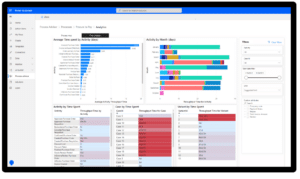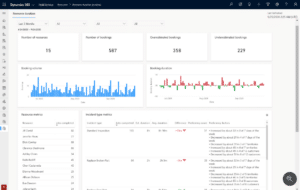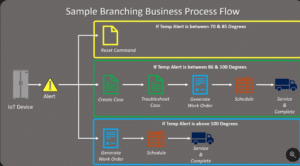Unlocking the Power of Process Automation in Field Service Management
Process automation is no longer a luxury it’s an essential. Learn why process automation is an essential for your company.
Process automation is no longer a luxury it’s an essential. Learn why process automation is an essential for your company.
Table of Content
As digital technologies continue to reshape industries, one thing is becoming increasingly clear: process automation is no longer a luxury — it’s an essential.
Between the dispatching and invoicing, manual processes and emergency service calls, poor visibility and communication challenges, field service ops often create a challenging environment for both field techs and their office-bound colleagues.
Teams strive to meet the expectations outlined in each SLA and warranty, all while juggling last-minute emergencies that throw a wrench into the best-laid plans.
Often, field technicians are burdened with extra work, inflating labor costs for the company. Worse, they may arrive on site with little to no information about the problem at hand, let alone the necessary parts and resources to resolve the issue during the first visit.
Luckily, process automation can tackle these challenges head-on – automating complex, time-consuming tasks and increased efficiency and reduced labor costs.
In this article, we explore how process automation is being used to improve field service operations.
As a concept, process automation is pretty straightforward. In this context, automation focuses on leveraging technology to automate and streamline the various tasks and processes performed by field techs, support staff, and other stakeholders each day.
This allows field providers to become more responsive to customer needs and enables field service mobility and gives technicians and back-end employees more time to work on high-value tasks.
It’s also incredibly expansive. You can automate the full spectrum of back-office operations – spanning everything from simple data entry tasks to intelligent onboarding, process mining, and route optimization.
That inherent “open-endedness” can make things harder on FSM leaders just beginning their digital journey.
According to Erica Ellis, a Principal Consultant at Velosio, “automating scheduling has a massive impact on scalability. Organizations often need a team of people to manually schedule work orders, but automated scheduling allows them to schedule thousands of resources without much human intervention.”
Still, process automation isn’t a magic bullet. As Microsoft points out in this intelligent automation one-pager, many orgs don’t think holistically when it comes to automation. What ends up happening is, companies digitize a handful of tasks here and there. And, at first, they might see some gains.
The problem is, one-off automations can’t scale, preventing service providers from reaping the high-level rewards that really make a difference.
It’s important to understand that you’re not digitizing and automating all business processes in one go. Rather, you’ll want to start by focusing on low-hanging fruit (i.e.: digitizing analog processes and automating basic data entry tasks) and high-impact areas (think – scheduling, resource management, and customer service).
As an example, G&J Pepsi built a customer engagement management (CEM) platform by combining D365 Field Service and Sales modules. Initially, they used the new system to establish a single source of truth, streamline communications, and automate basic tasks like data entry and assigning work orders.
Automating routine tasks allowed G&J Pepsi to unburden employees from tedious admin work and eliminate the “little things” that used to cause bottlenecks and delays. Techs can now access all details related to each call directly from the mobile app, boosting first-time-fix rates and unlocking new revenue streams that leverage tech expertise.
Now, G&J is focused on building out their automation strategy.
When someone completes certain tasks in D365, it triggers a Power Automate flow that begins another process. So, if a customer submits a service request, that action sets off a trigger that generates a new work order, which is then routed to the equipment prep team, then scheduling, and finally, off to the tech for service.
Like G&J, you can also use Power Automate to enable Business Process Automation (BPA) sequences to help you reach key goals – and to establish consistency across key processes.
Record actions in real-time, then use those insights to design processes that support end-user goals.

The Power Platform should cover most of your process automation needs, but you might look into ISV solutions if you need something specific and/or don’t want to start from scratch.
AppSource features a ton of apps that focus on specific tasks like accounts payable or document automation. You can also find a handful of low-code tools designed for more complex processes.
There’s North52 BPA, a ‘low or no code’ tool that comes with a point-and-click user interface just about anyone can use.
There’s also Aptean Advanced Workflow, a workflow automation platform that allows BC users to streamline and automate complex business processes.
They may be a little late to the game, but field service orgs are finally seeing this huge influx of data coming from IoT devices, customers, processes, and whatever else is connected to their digital ecosystem.
All of that data can be used to improve workflows, boost productivity, and drive better service outcomes.
Velosio Principal Consultant Dave Sigler says, “having all these different technologies gives field providers the insights they need to improve process efficiency, which, in turn, impacts profitability.”
Sometimes, Dave says, “it even transforms cost centers into valuable sources of revenue.”
But – a big part making that shift from costs to profits is leveraging the performance and process data your FSM tools are already generating. And, process automation goes a long way in helping service providers put that data to work.
You can use Power BI to generate comprehensive (and super-specific) reports based on field service data — providing valuable insights into performance, productivity, and customer satisfaction.
This allows you to move beyond the canned reports that came with your ERP and instead, tap into visual dashboards and AI insights that will ID opportunities for improvement — and tell you what to do next.
Power BI can also be used with other Power Platform tools to build specialized reporting tools.
So, you can either go the DIY route or use existing industry solutions available through AppSource or your Microsoft Partner.
For example, we built the Power BI for Field Services Simulation to help our FS clients make data-driven decisions by modeling different “what-if” scenarios.
The tool works a lot like those digital credit calculators, allowing users to analyze the impact of potential improvements by focusing on individual variables. Think — pricing, routes, or inventory.
You might also use the MS Power Automate Process Advisor to uncover optimization opportunities. The platform captures rich, visual insights that help you understand your workflows so you can instantly ID and fix inefficiencies.
Here, you can see how granular these insights can get – this example focuses exclusively on how much time is spent on procure-to-pay activities.

If you’re using D365 Field Service, MS just launched a new Predictive Work Duration Report (currently in preview). The new reporting tool uses AI models that analyze historical data to make informed predictions about future scheduling outcomes – helping field orgs improve overall efficiency.
The built-in AI looks at durations by resource performance, incident type, account, and other factors to determine how each service should be scheduled.

As your digital strategy matures, you’ll amass more and more data – data that can later be used to fuel more powerful automations.
As an example, let’s say you’ve successfully integrated data from IoT–enabled assets and are already using advanced analytics to move toward a predictive service model.
If you’re using D365, you can use that data to design processes for connected field service.
This means, automated workflows can integrate with asset monitoring systems to enable proactive maintenance and remote diagnostics.
The system can continuously collect data from connected assets, analyze it in real-time, and automatically trigger service requests or preventive maintenance tasks when specific conditions or thresholds are met.
Here’s an example of what a process flow for an IoT alert might look like:

Here, real-time data from assets is continuously monitored, and using AI-driven algorithms, potential failures can be predicted before they occur.
Once an issue is detected, automated workflows can trigger service requests, ensuring the problem is addressed swiftly and effectively.
Now, there are many different ways you might use AI to build intelligent workflow automations.
One company, Johnson Controls, used the Power Platform to enable training at-scale and streamline back-office processes – saving them a whopping 3,610 hours and increasing training throughput by 400%.
Additionally, Microsoft just rolled out several new Power Automate features for building and orchestrating automated workflows – and Copilot (MS’s new AI assistant) is now available in preview to Power Automate users.
By streamlining workflows, improving accuracy, and unlocking powerful insights, process automation is driving next-level improvements across the entire FSM stack.
Where other field service automation practices might opt for a sales-first approach, Velosio focuses on solutions and outcomes. Client engagements start with us asking lots of questions.
That way, we can get a clear picture of what your field service ops look like right now – and what it’ll take to make things better. And, that’s both in the super short-term and many years (and incremental upgrades) down the line.
Contact us today to learn more about our FSM practice, experience, and what, exactly, we can do for your field service org.
Talk to us about how Velosio can help you realize business value faster with end-to-end solutions and cloud services.
"*" indicates required fields